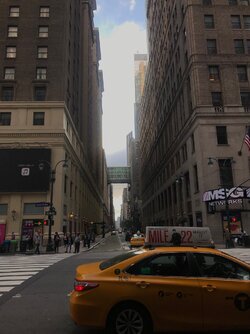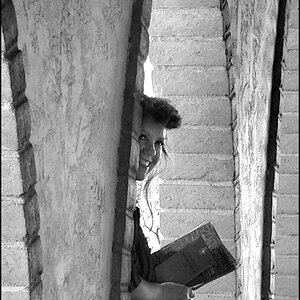Navigation
Install the app
How to install the app on iOS
Follow along with the video below to see how to install our site as a web app on your home screen.

Note: This feature currently requires accessing the site using the built-in Safari browser.
More options
You are using an out of date browser. It may not display this or other websites correctly.
You should upgrade or use an alternative browser.
You should upgrade or use an alternative browser.
Help please! I need help with a project
- Thread starter Pepps
- Start date
- Joined
- Jul 8, 2005
- Messages
- 45,747
- Reaction score
- 14,806
- Location
- Victoria, BC
- Website
- www.johnsphotography.ca
- Can others edit my Photos
- Photos OK to edit
Maybe start by giving us some more details? Is this your photo? What sort of critique? What's the goal of the project?
Pepps
TPF Noob!
- Joined
- Oct 25, 2018
- Messages
- 6
- Reaction score
- 0
- Can others edit my Photos
- Photos OK to edit
Maybe start by giving us some more details? Is this your photo? What sort of critique? What's the goal of the project?
Ok! Sorry this is the first photo assignment I’ve Ever done, and my teacher hasn't taught me anything.
So it says on the paper
“What are the Formal design reasons for the primary visual impact? (Composition, guidelines-simplicity, framing, rule of thirds, lines, balance, avoiding mergers, shapes, tones, textures, patterns, sizes, and their interactions)”
Pepps
TPF Noob!
- Joined
- Oct 25, 2018
- Messages
- 6
- Reaction score
- 0
- Can others edit my Photos
- Photos OK to edit
Maybe start by giving us some more details? Is this your photo? What sort of critique? What's the goal of the project?
Ok! Sorry this is the first photo assignment I’ve Ever done, and my teacher hasn't taught me anything.
So it says on the paper
“What are the Formal design reasons for the primary visual impact? (Composition, guidelines-simplicity, framing, rule of thirds, lines, balance, avoiding mergers, shapes, tones, textures, patterns, sizes, and their interactions)”
The only thing my teacher has taught us so far is to photo shop our face onto an animal, so I’m just kinda lost.
greybeard
Been spending a lot of time on here!
- Joined
- Dec 30, 2011
- Messages
- 4,501
- Reaction score
- 1,811
- Location
- WV
- Can others edit my Photos
- Photos OK to edit
So, your teachers has not gone over " Formal design reasons for the primary visual impact? (Composition, guidelines-simplicity, framing, rule of thirds, lines, balance, avoiding mergers, shapes, tones, textures, patterns, sizes, and their interactions" and you don't have any kind of a textbook describing these elements of a picture?
- Joined
- Mar 18, 2013
- Messages
- 15,456
- Reaction score
- 15,353
- Location
- Boston
- Can others edit my Photos
- Photos OK to edit
You should contact your teacher for assistance. He should be able to direct you to resources so you can learn the material to do the assignment.
vintagesnaps
Been spending a lot of time on here!
- Joined
- Jan 13, 2013
- Messages
- 9,119
- Reaction score
- 3,109
- Location
- US
- Can others edit my Photos
- Photos NOT OK to edit
Besides asking your teacher, I'd say you need to read any material (what else does your paper say?) and maybe do some research on composition. If there's not a text book, are there maybe handouts or websites the teacher gave out? I'm not sure how you'd be expected to know all that without some reading materials.
My background is in education but infant/toddler development. What you quoted from the paper sounds like a lot to consider in one photo for critique. Of course I don't know what grade or class this is to know what you may have already been studying in class. If you're this lost you probably better talk to your teacher and find out what to do from here.
Meanwhile for this assignment you could look up 'elements of composition in art' and 'principles of composition in art' (and yes, I took all kinds of art all through school! lol). Search for it 'in art' rather than photography to get reliable information, otherwise it'll bring up sites by people selling videos and books, etc., or other info. that I've often found to be inaccurate and unreliable).
Edit - Searching that should bring up sites like The Getty museum, Kennedy (Center) Artsedge, etc. The Artist's Toolkit: Encyclopedia: Balance | ArtsConnectEd
If you want your photo critiqued, I'd say what I think you were going for was using lines and perspective. To me it worked in the upper part of the photo better than the lower part. If the cab was part of the picture, it needed to be in the frame or you needed to wait til it moved on. (If it was stopped, you could've changed your vantage point or your framing; you could've flipped the camera and shot it horizontally, but that would give you a totally different picture; if it was moving you might have been able to catch it in the frame but it takes practice to think and get a shot on the fly.) It has a bit of an odd angle so if you use that, think about how things work in the frame - do you want an odd edge of a red/orange door to the left? do you want trash cans/people? if so where should they be in the frame? Do you want the lean you got with the lens you used? Did that help or work against getting the buildings in the picture?
If you intended to show the interesting angle and perspective between the two buildings, I do see that so I think that shows in the photo. I think you made use of shape in the buildings. I think that gets 'lost' in the bottom part of the photo. Without the cab there you could've made better use of the white lines of the crosswalk and that pattern/texture to balance the height of the buildings. If you wanted to show the difference in size between the people and the buildings, the cab just makes for a big bright yellow distraction.
Get some help from your teacher and keep in mind that learning photography and getting good at composing and framing images takes time.
My background is in education but infant/toddler development. What you quoted from the paper sounds like a lot to consider in one photo for critique. Of course I don't know what grade or class this is to know what you may have already been studying in class. If you're this lost you probably better talk to your teacher and find out what to do from here.
Meanwhile for this assignment you could look up 'elements of composition in art' and 'principles of composition in art' (and yes, I took all kinds of art all through school! lol). Search for it 'in art' rather than photography to get reliable information, otherwise it'll bring up sites by people selling videos and books, etc., or other info. that I've often found to be inaccurate and unreliable).
Edit - Searching that should bring up sites like The Getty museum, Kennedy (Center) Artsedge, etc. The Artist's Toolkit: Encyclopedia: Balance | ArtsConnectEd
If you want your photo critiqued, I'd say what I think you were going for was using lines and perspective. To me it worked in the upper part of the photo better than the lower part. If the cab was part of the picture, it needed to be in the frame or you needed to wait til it moved on. (If it was stopped, you could've changed your vantage point or your framing; you could've flipped the camera and shot it horizontally, but that would give you a totally different picture; if it was moving you might have been able to catch it in the frame but it takes practice to think and get a shot on the fly.) It has a bit of an odd angle so if you use that, think about how things work in the frame - do you want an odd edge of a red/orange door to the left? do you want trash cans/people? if so where should they be in the frame? Do you want the lean you got with the lens you used? Did that help or work against getting the buildings in the picture?
If you intended to show the interesting angle and perspective between the two buildings, I do see that so I think that shows in the photo. I think you made use of shape in the buildings. I think that gets 'lost' in the bottom part of the photo. Without the cab there you could've made better use of the white lines of the crosswalk and that pattern/texture to balance the height of the buildings. If you wanted to show the difference in size between the people and the buildings, the cab just makes for a big bright yellow distraction.
Get some help from your teacher and keep in mind that learning photography and getting good at composing and framing images takes time.
Last edited:
ceemac
No longer a newbie, moving up!
- Joined
- Oct 8, 2017
- Messages
- 473
- Reaction score
- 226
- Location
- Cariboo, B.C.
- Can others edit my Photos
- Photos OK to edit
“What are the Formal design reasons for the primary visual impact? (Composition, guidelines-simplicity, framing, rule of thirds, lines, balance, avoiding mergers, shapes, tones, textures, patterns, sizes, and their interactions)”
Not even the question makes sense. The primary visual impact for me is the subject of the picture. The subject is decided by the photographer using the other things in the brackets, which are the basics of composition. Each of these other items, either alone or in combination with others, help define my primary visual impact. In other words, you tell me what the subject is, using rule of thirds, leading lines, framing etc. How you compose the picture tells me what's important.
ceemac
No longer a newbie, moving up!
- Joined
- Oct 8, 2017
- Messages
- 473
- Reaction score
- 226
- Location
- Cariboo, B.C.
- Can others edit my Photos
- Photos OK to edit
My brain hurts now, but you're not wasting anyone's time.Ok! I’ll try that. I’m sorry if I’m wasting your time guys. But thank you!
greybeard
Been spending a lot of time on here!
- Joined
- Dec 30, 2011
- Messages
- 4,501
- Reaction score
- 1,811
- Location
- WV
- Can others edit my Photos
- Photos OK to edit
As a retired educator of 39 years, I'm am somewhat embarrassed by this. You are not wasting our time. The question is so overly worded and convoluted that it is tough for people who work with and live with photography on a daily basis to understand what your teacher wants.
TCampbell
Been spending a lot of time on here!
- Joined
- Mar 31, 2012
- Messages
- 3,614
- Reaction score
- 1,556
- Location
- Dearborn, MI
- Can others edit my Photos
- Photos OK to edit
The question actually does make sense to me. The part I'm hazy on is... is this YOUR photo... or did the teacher assign the photo to the students and tell them to critique it so that all students are critiquing the same photo?
If you were to read a book such as "The Photographer's Eye: Composition & Design for Better Digital Photos" by Michael Freeman, you'd pick up on a LOT of ideas around the topic of "composition".
There are lots of elements or tools you can use when composing a shot to create interest...
"Rule of thirds" is extremely popular (and well-known)
There are also ideas around "balance" and the notion that object sizes and densities (tonality) creates "weight" and you can position subjects in the frame to create a sense of balance based on weighting. While you can create a sense of balance based on weighting... you can also create a sense of balance based on color (e.g. colors which are "opposite" on the color-wheel tend to look good together ... for example, blue & gold ... so maybe you compose a photo of a fall color tree with gold autumn leaves against a strong blue sky because those colors go well together to create balance of color.
There's a notion of "leading lines" -- your eyes tend to follow lines or line-like things or anything that gives direction to your eyes ... to move your eyes around the photo. e.g. if a subject in a photo is looking at something... your eyes will tend to follow to see what it is that this subject is "looking at". But it could be lines on buildings, roads, fences, it could be the mortar in a brick wall... anything that can create a sense of direction can "lead" your eye. Typically you would "lead" the viewers eye to the thing you want them to look at.
Anyway, without getting into all of them ... there are loads of compositional techniques you can use. As mentioned above... there is so much to cover that people write entire books on just the topic of "composition".
In any single photo, you wouldn't employ all of these techniques... you might only employ one. Beginner photographers might have one in the shot by accident.
When I look at the photo supplied, I see that it doesn't follow things like "rule of thirds". It almost, but does not quite, use "symmetry". It moderately has "balance" in that a large building on the right is offset by a large building on the left (but this balance appears more accidental than deliberate). The street and the horizontal design elements on the building act as "leading lines" to guide your eyes down the street (ideally they would lead you to something of interest rather than disappear at the vanishing point.)
While there are leading lines (horizontal architectural elements) the verticals are not straight (caused by a camera lens that was not level ... this camera was tilted slightly upward when the shot was taken). Sometimes leaning verticals can be an asset (especially if they create geometric shapes) but not so much in this case.
If this is a first lesson... my "guess" is ... maybe you're being shown this image to see what you can make of it (a sort of pre-assessment), then you get some formal training... then you re-assess the image to see how much you now notice after having gone through the class. I've seen educators use pre-assessments before... but it usually isn't a mystery to the students (they know they're being asked to take a pre-assessment on material they have not yet covered and are not expected to do well.) The idea is you then compare "before this class I did poorly... after this class I did well... this must have been a worthwhile class." (Or maybe it's just a poor instructor?)
As I look at THIS photo, I get the sense that the photographer was probably attracted primarily to the view down the avenue between the buildings ... they were interested in the "leading lines" that go into a vanishing point. I mentioned a few other elements, but they don't appear to be deliberately placed. My suspicion is that the photographer may not have been aware of those elements and did not make an attempt to employ them.
If you were to read a book such as "The Photographer's Eye: Composition & Design for Better Digital Photos" by Michael Freeman, you'd pick up on a LOT of ideas around the topic of "composition".
There are lots of elements or tools you can use when composing a shot to create interest...
"Rule of thirds" is extremely popular (and well-known)
There are also ideas around "balance" and the notion that object sizes and densities (tonality) creates "weight" and you can position subjects in the frame to create a sense of balance based on weighting. While you can create a sense of balance based on weighting... you can also create a sense of balance based on color (e.g. colors which are "opposite" on the color-wheel tend to look good together ... for example, blue & gold ... so maybe you compose a photo of a fall color tree with gold autumn leaves against a strong blue sky because those colors go well together to create balance of color.
There's a notion of "leading lines" -- your eyes tend to follow lines or line-like things or anything that gives direction to your eyes ... to move your eyes around the photo. e.g. if a subject in a photo is looking at something... your eyes will tend to follow to see what it is that this subject is "looking at". But it could be lines on buildings, roads, fences, it could be the mortar in a brick wall... anything that can create a sense of direction can "lead" your eye. Typically you would "lead" the viewers eye to the thing you want them to look at.
Anyway, without getting into all of them ... there are loads of compositional techniques you can use. As mentioned above... there is so much to cover that people write entire books on just the topic of "composition".
In any single photo, you wouldn't employ all of these techniques... you might only employ one. Beginner photographers might have one in the shot by accident.
When I look at the photo supplied, I see that it doesn't follow things like "rule of thirds". It almost, but does not quite, use "symmetry". It moderately has "balance" in that a large building on the right is offset by a large building on the left (but this balance appears more accidental than deliberate). The street and the horizontal design elements on the building act as "leading lines" to guide your eyes down the street (ideally they would lead you to something of interest rather than disappear at the vanishing point.)
While there are leading lines (horizontal architectural elements) the verticals are not straight (caused by a camera lens that was not level ... this camera was tilted slightly upward when the shot was taken). Sometimes leaning verticals can be an asset (especially if they create geometric shapes) but not so much in this case.
If this is a first lesson... my "guess" is ... maybe you're being shown this image to see what you can make of it (a sort of pre-assessment), then you get some formal training... then you re-assess the image to see how much you now notice after having gone through the class. I've seen educators use pre-assessments before... but it usually isn't a mystery to the students (they know they're being asked to take a pre-assessment on material they have not yet covered and are not expected to do well.) The idea is you then compare "before this class I did poorly... after this class I did well... this must have been a worthwhile class." (Or maybe it's just a poor instructor?)
As I look at THIS photo, I get the sense that the photographer was probably attracted primarily to the view down the avenue between the buildings ... they were interested in the "leading lines" that go into a vanishing point. I mentioned a few other elements, but they don't appear to be deliberately placed. My suspicion is that the photographer may not have been aware of those elements and did not make an attempt to employ them.
Designer
Been spending a lot of time on here!
- Joined
- Apr 13, 2012
- Messages
- 18,505
- Reaction score
- 4,853
- Location
- Iowa
- Can others edit my Photos
- Photos OK to edit
It might be (as vintage snaps has said) some measure of your ability and education level at the beginning of the course. Hopefully, you will learn all that and more as the class progresses.No, he hasn’t. That’s why I’m so confused on this. I don’t understand why he would give us this if we haven’t learned it.
Anyway, either get a book on design or search online for the terms, and you will by necessity teach yourself those terms.
Good luck!
Similar threads
- Replies
- 1
- Views
- 341
- Replies
- 6
- Views
- 454







![[No title]](/data/xfmg/thumbnail/34/34065-43f99c081a04bd087c00711d2fe010ee.jpg?1619736261)





